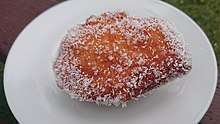Koe'sister
 | |
| Type | Pastry |
|---|---|
| Course | Dessert |
| Place of origin | South Africa |
| Main ingredients | Dough, sugar syrup, desiccated coconut |
A Koe'sister or Koesister is a traditional Cape Malay pastry often described as a spicy dumpling with a cake-like texture, finished off with a sprinkling of coconut.[1]
Cape Malay koe'sisters are prepared from balls of dough including yeast and flavoured with cinnamon, aniseed, ginger, cardamom and dried tangerine skin powder, deep-frying in oil, allowing to cool, then cooking for a minute in boiling syrup and rolling in desiccated coconut.[2]
The frying of dough strips in this manner is of Malay/Indonesian origin, possibly with Indian influence, originally eaten as an unsweetened breakfast savoury brought to South Africa with Malay slaves,[3] among whom they were known as koe'sisters, apparently suggesting polite gossiping among spinsters.
Cape Malay koe'sisters are different to the similar sounding Afrikaner version, Koeksister, which is a crisp and syrupy twisted or plaited doughnut and usually served ice cold.[4][5]
References
- Coetzee, Renate (2012). Spys en Drank.
- Gerber, Hilda (1959). Traditional cookery of the Cape Malays.
- ↑ "Cape Malay Koesisters". Gateway Magazine.
- ↑ Duckitt, Hildagonda J (1891). "KOESISTERS". Hilda's "where is it?" of recipes. London: Chapman and Hall.
- ↑ Green, Lawrence (1949). "Chapter 4 - Country Hospitality". In the Land Of Afternoon. Howard Timmins.
- ↑ "Koeksisters". Huisgenoot Wenresepte. Retrieved 13 September 2017.
- ↑ "Koeksisters vs Koesisters". lizeme. Retrieved 13 September 2017.